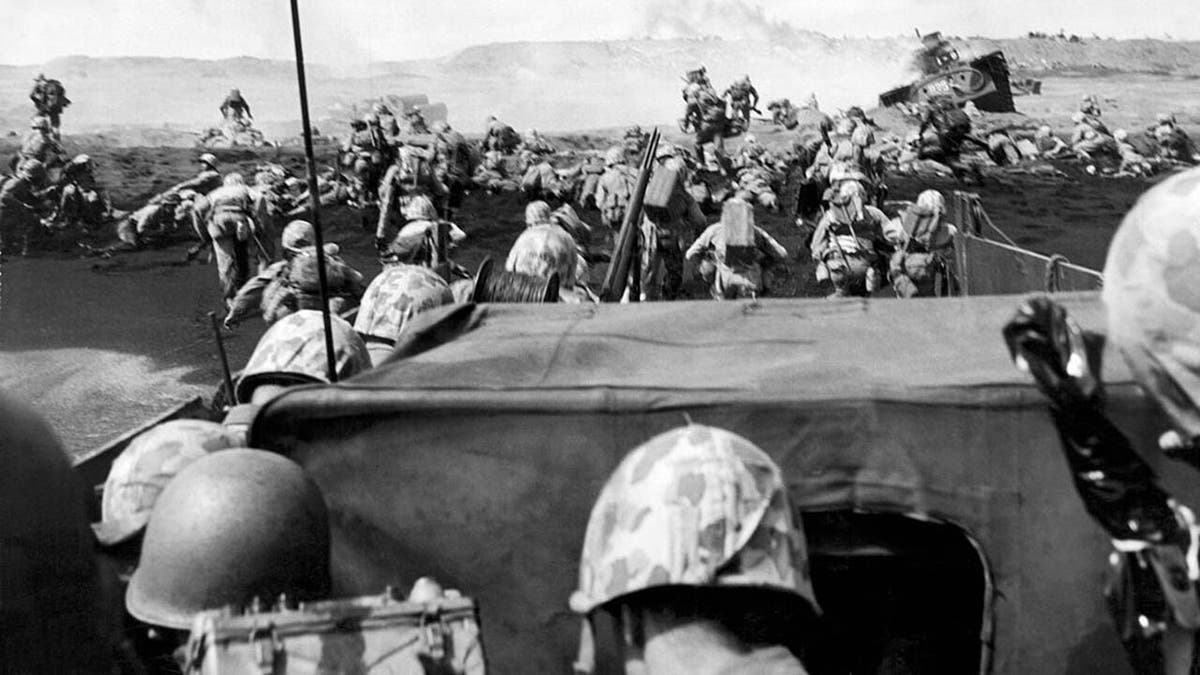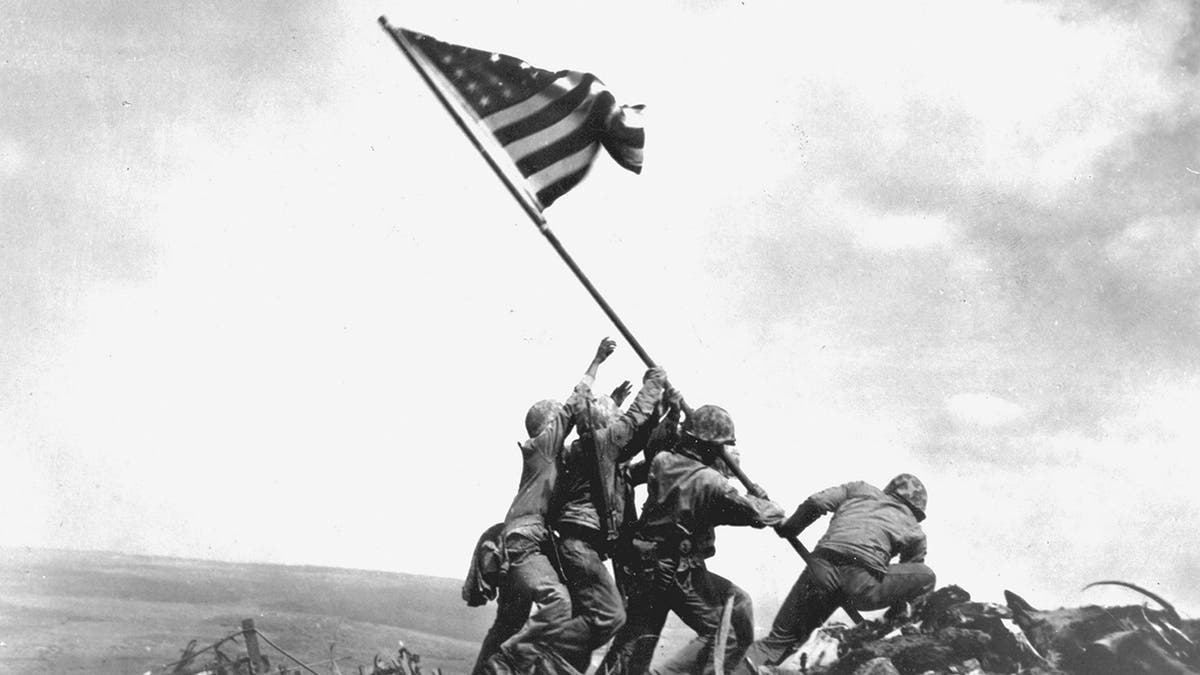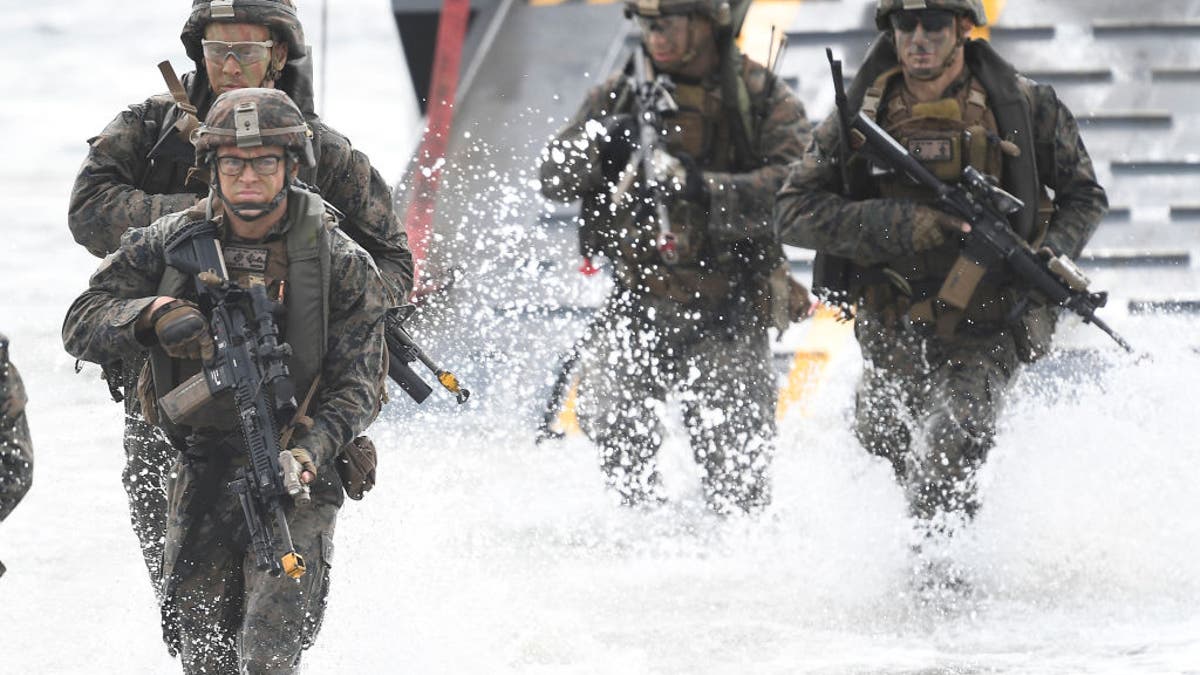This man was the first commandant of the U.S. Marine Corps — here's his amazing story
Samuel Nicholas was born into a Philadelphia Quaker family in 1744 — learn much more about him here.
Major Samuel Nicholas enjoys a distinction in the heroic history of the United States Marine Corps that will never be supplanted.
He was the first Marine.
The Philadelphia Quaker, orphaned as a 7-year-old boy, answered the call of a rebellious new nation and organized the first battalions of Continental Marines in Philadelphia in November 1775, in the early days of the American Revolution.
Just four months later, then-Captain Nicholas led his untested fighting force to face the enemy overseas with a daring amphibious raid on a British military depot in Nassau, Bahamas.
"The first landing party ever engaged in by Continental Marines," notes Marine Corps University, "was a complete success."
"Samuel Nicholas is an American hero," Kater Miller, a curator from the National Museum of the Marine Corps in Virginia, told Fox News Digital.

Samuel Nicholas was a member of elite Philadelphia society when he raised the first unit of 300 Marines in late 1775 — and led them into battle on March 3, 1776. (United States Marine Corps, public domain)
"He and his Marines boarded the second-rate ships of the untried American navy, ships led by untested military captains, and took to the high seas to face the most powerful navy in the world at the time."
The Raid on Nassau, as it’s known today, set the precedent for future assaults from sea for which the Marine Corps is now famous.
"The first landing party ever engaged in by Continental Marines was a complete success."
Nicholas's Continental Marines, the precursor of the United States Marine Corps, were founded by order of the Second Continental Congress on Nov. 10, 1775 — the date celebrated as the Marine Corps birthday by Devil Dogs around the world today.
The Continental Marines were disbanded in 1783, at the end of the American Revolution, to be reformed as the United States Marine Corps in 1798.

The First Continental Marines recruited by Captain Samuel Nicholas in 1775 for duty in the Revolutionary War. (Getty Images)
Major Nicholas is by tradition recognized as the first commandant of this elite American fighting force.
His fearless and patriotic devotion to the new nation came at time of great uncertainty.
George Washington in November 1775 was attempting to whip New England's ragtag Minutemen into a legitimate fighting force as they lay siege to the Redcoats in Boston.
Ordinary Americans weighed the next steps on which their own lives, and ultimately the fate of the world, would rest: Commit treason and join the rebellion — or proclaim fealty to the Crown.

The amphibious assault ship USS Nassau (LHA 4) receives a landing craft air cushion (LCAC) as it transits on January 25, 2010, on a humanitarian relief effort near the Haitian coast. The Nassau was named for the first raid by Continental Marines on Nassau, Bahamas, in March 1776. (Photo by Jason R. ZalaskyU.S. Navy via Getty Images)
Colonial leaders weighed next steps too. Their most daring and unified challenge to British authority, the Declaration of Independence, was still eight months away.
Captain Nicholas displayed no hesitation.
He sowed the seeds of dauntless courage that would make the few, the proud, the Marines the most successful seaborne raiders the world has even seen.
Orphaned boy joins Philadelphia society
Samuel Nicholas was born to Quaker parents, Anthony and Mary (Shute) Nicholas, in Philadelphia on an unknown date in 1744.
"He organized the Gloucester Fox Hunting Club, one of the first hunting clubs in America. He was also involved in the Patriotic Association of Philadelphia."
His mother died when he was 6 years old; his father, a well-known local blacksmith and apparent alcoholic, died when Samuel was just 7.
The orphan Nicholas had the great fortune to be adopted by his well-connected uncle, Attwood Shute, who served as mayor of Philadelphia from 1756 to 1758.

Samuel Nicholas was commissioned first captain of the Marine Corps by the Second Continental Congress, as signed by its president, John Hancock, on Nov. 28, 1775. The commission denotes the body's trust and confidence in Nicholas's "patriotism, valor, conduct and fidelity … for the defense of American liberty." (Courtesy Marine Corps History Division Archives)
"His uncle paid for him to attend the Philadelphia Academy … When he turned 16, he was admitted into the Schuylkill Fishing Company, a very exclusive club in Philadelphia," reports Penn State University’s Pennsylvania Center for the Book.
"Not long after, in 1766, he organized the Gloucester Fox Hunting Club, one of the first hunting clubs in America. He was also involved in the Patriotic Association of Philadelphia."
MEET THE AMERICAN WHO WROTE ‘THE BATTLE HYMN OF THE REPUBLIC’
Nicholas was a gentleman of distinction when the Second Continental Congress in Philadelphia resolved on Nov. 10, 1775 "that two battalions of Marines be raised."
Nicholas received his commission to lead the new service just 18 days later.
"We, reposing especial trust and confidence in your patriotism, valor, conduct and fidelity, do by these presents appoint you to be Captain of the Marines, in the service of the thirteen United Colonies of North-America, fitted out for the defense of American liberty and for repelling every hostile invasion thereof," reads his appointment from the Second Continental Congress.

This undated engraving shows the scene on July 4, 1776, when the Declaration of Independence, drafted by Thomas Jefferson, Benjamin Franklin, John Adams, Philip Livingston and Roger Sherman, was approved by the Continental Congress in Philadelphia. (AP Photo)
The commission bears the soon-to-be famous signature of the body's president, John Hancock.
"Captain Nicholas no sooner received official confirmation of his appointment to office than he began recruiting for the Marines in Philadelphia," reports Marine Corps University.
He soon had a force of some 300 men under his command.
"[With] confidence in your patriotism, valor, conduct and fidelity … [we] appoint you to be Captain of the Marines." — Continental Congress to Captain Nicholas
"By January 1776, having recruited a sufficient number of Marines to man the vessels that comprised the Continental Navy in the waters of Philadelphia, Capt. Nicholas assumed command of Marine Detachment on board the Alfred," reports Marine Corps University.
"With Commodore (Esek) Hopkins in command, the Alfred set sail from Philadelphia on the morning of 4 January 1776."
The Marines, only a few weeks old, would soon begin to forge their legacy.
The first seaborne assault
It took an immense amount of bravery for the untested Marines to board what passed for America's navy at the time.
"The Continental Navy of 1776 was a collection of converted merchantmen and auxiliaries, none of which would be reasonably called a warship," writes historian John D. Gresham in his Defense Media Network account of the Raid on Nassau.

New Providence Raid, March 1776, oil painting on canvas by V. Zveg, 1973, depicting Continental Sailors and Marines landing on New Providence Island, Bahamas, on March 3, 1776. (U.S. Naval History and Heritage Command, public domain)
"Similarly, the Continental Marines, while patterned after the Royal Marines and their tradition of security and raiding operations, had little of the esprit and professionalism for which they are known today."
It fell upon Nicholas and his men to begin the long process of building the esprit de corps of an entire new fighting force in service of a nation not yet founded.
The effort began with their daring raid in the Bahamas.
"Arriving off New Providence Island on March 2, Hopkins had the distinction of giving, for the first time by an American commander, the order, ‘Land the landing force," writes Gresham.
"They seized two dozen casks of gunpowder, 88 cannons, 15 mortars and other provisions."
"While Nicholas’ Marines and Hopkins’ sailors were little more than raw recruits, the operation had gone surprisingly well, providing the new sea service with the first chapter of what is today a [246-year] legacy."
The Marines moved swiftly and faced little resistance during the raid on March 3rd and 4th. They seized two dozen casks of gunpowder, 88 cannons, 15 mortars and other provisions.

Fourth Division Marines charging from their landing craft onto the beach in the battle at Iwo Jima, Iwo Jima, Japan, on March 2, 1945. (Photo by Underwood Archives/Getty Images)
The Nassau Raid "appeared to augur well for the institutional integrity of the Continental Marines," historians Merrill Bartlett and Jack Sweetman wrote in their 2008 tome, "Leathernecks: An Illustrated History of the United States Marine Corps."
Nicholas’s Marines, they noted, "had functioned as a battalion of the sort envisioned by the Corps founding legislation and in the type of amphibious operation that legislation anticipated."
Nicholas had set the precedent for the Marines to become the world's most formidable sea-to-land fighting force.
TRAVIS MANION FOUNDATION HOSTS MARINE CORPS MARATHON SUNDAY
Their skills as amphibious warriors were displayed most heroically in World War II, when Marines leaped from landing craft onto one Pacific Island after the other, constricting and ultimately suffocating the once unstoppable Japanese Empire.
About 90,000 Marines were killed or wounded in the four-year struggle.
That heroic capability was symbolically captured in photographer Joe Rosenthal's powerful image from World War II: six Marines famously unfurling the American flag atop Mount Suribachi on Iwo Jima on Feb. 23, 1945.

Flag raising on Iwo Jima. From left, PFC Ira Hayes, PFC Harold Schultz, Sgt. Michael Strank (KIA), PFC Franklin Sousley (KIA), PFC Harold Keller and Cpl. Harlon Block (KIA). Marine Pfc. Louis Charlo helped pioneer a path to the site where the iconic image was taken. (Photo by: Photo 12/Universal Images Group via Getty Images)
It is considered by many the greatest photograph in American history.
The Marines who lifted the flag that day had climbed from the sea and stormed the black sand beaches of Iwo Jima just four days earlier.
Nicholas, the architect of the first Marine Corp landing, was promoted to major after the success of the Nassau raid. It would prove the Marines' single greatest engagement of the American Revolution.
"Nicholas set the precedent for the Marines to become the world's most formidable sea-to-land fighting force."
"Following the evacuation of Philadelphia by the British in June 1778, Marine Barracks were reestablished and recruiting renewed," writes Marine Corps University.
"From then until the close of the war, Maj. Nicholas' duties at Philadelphia were somewhat similar to those of later Commandants. Moreover, he was actively in charge of recruiting, and at times acted as Muster Master of the Navy."
First ‘soldier of the sea’
Major Samuel Nicholas died in Philadelphia on August 27, 1790, amid a yellow fever epidemic.
He had been ex-communicated at some point by the Quakers because his military service contradicted church doctrine. But he was buried in their fold at the Society of Friends Cemetery in Philadelphia.

Portrait of first leader of the Marines, Major Samuel Nicholas. This portrait hangs in the Commandant’s house and was originally created by Maj. Donna J. Neary, USMCR, in 1989; the likeness was produced with reference to antique miniatures and other sources. (U.S. Marine Corps, public domain)
The destroyer USS Nicholas (DD-449), named in his honor, earned a U.S. Navy record 30 battle stars in its 27 years of service in World War II, Korea and Vietnam. It was replaced by the frigate USS Nicholas (FFG 47), which served the U.S. Navy for 30 years, from 1984 to 2014.
Major Nicholas's Nassau Raid has also been honored by the U.S. Navy.
The escort carrier USS Nassau (CVE 16) scoured the Pacific in several major encounters in World War II. The amphibious assault ship USS Nassau (LHA 4) served the U.S. Navy for 32 years, from 1979 to 2011.
CLICK HERE TO SIGN UP FOR OUR LIFESTYLE NEWSLETTER
The Marines today have the ability to insert from sea to land combat forces and equipment, or humanitarian aid anywhere in the world — often doing both in the same deployment, notes Miller of the National Museum of the Marine Corps.
Marine Corps recruits are drilled in service history and lore. The name of first commandant Samuel Nicholas is at the tip of the tongue of every new Marine.

U.S Marines can be seen disembarking form a landing craft as part of an amphibious landing on July 22, 2019, in Bowen, Australia. Exercise Talisman Sabre 2019 is the largest exercise that the Australian Defence Force (ADF) conducts with all four services of the U.S. armed forces. (Photo by Ian Hitchcock/Getty Images)
The Marines served heroically in Europe in World War I, but as a land force in conjunction with the U.S. Army. The Marines faced the very real possibility of being disbanded or absorbed by the Army after the Great War.
"The attitude was that we don't need two land armies," said Miller.
But Marine Corps planners, including legendary Commandant General John Lejeune, knew that that future wars would require a mobile amphibious force capable of engaging the enemy quickly in all corners the world.
They tapped the legacy of Nicholas to reconfirm and reestablish the Marine Corps' future capabilities as seaborne raiders.
CLICK HERE TO GET THE FOX NEWS APP
Lejeune also channeled the spirit of Major Nicholas and the first Marines when he issued Marine Corps Order No. 47 — read by Marines around the world each Nov. 10 on the birthday of the Corps.
"So long as that spirit continues to flourish Marines will be found equal to every emergency in the future as they have been in the past, and the men of our Nation will regard us as worthy successors to the long line of illustrious men who have served as ‘Soldiers of the Sea’ since the founding of the Corps."
That long line of illustrious men began with Major Samuel Nicholas in November 1775.
To read more stories in this unique "Meet the American Who…" series from Fox News Digital, click here.





















